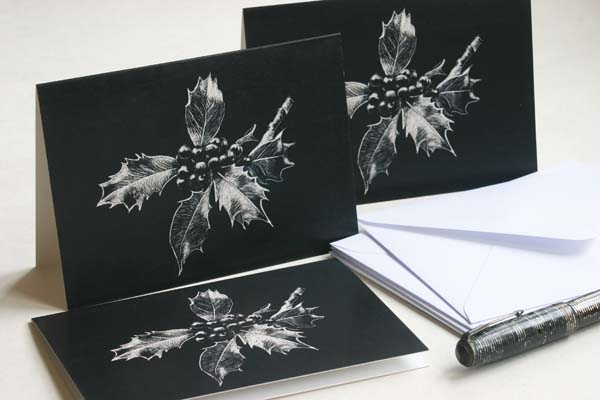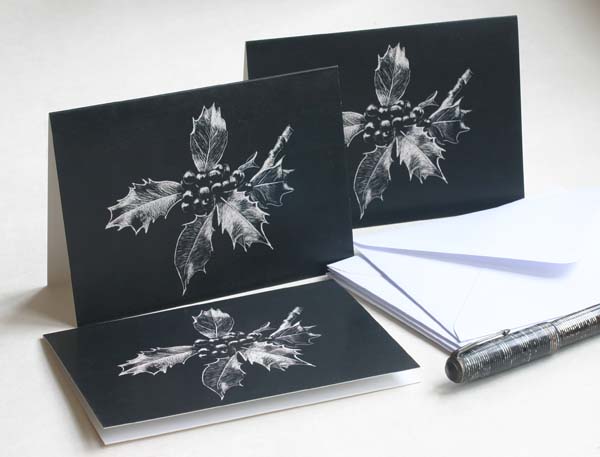Holly Sprig

There’s a holly growing in the hedgerow at my workshop, it is where the blackbird nested this year and it is usually busy with birds flitting to and fro and disappearing into its thick mass of prickles. A sprig was plucked from it for this scraperboard drawing – and made into a Christmas card (available now in my shop).

There’s so much fascinating folk-lore surrounding the holly tree, which I love learning about, and it is a huge part of our decorative expression at Christmas – I always look forward to bringing holly into the house, which always gives instant festive feel. There are lots of fascinating details at Trees for Life – about holly and this informative extract from Alan Watson Featherstone there, about how holly reproduces. (Which is important if I’m to keep cutting sprigs!)
Holly is dioecious, so individual trees are either male or female (in contrast to most trees, such as Scots pine or oak, for example, where male and female flowers occur on the same tree). Flowering begins when a tree is about 20 years old, and the flowers appear in clusters near the base of the leaves. They are pinkish-red as buds, opening in May or June to reveal white flowers with 4 petals. The male flowers have stamens covered in pollen and sterile stigma that are reduced in size, whilst the females have larger stigma and smaller, sterile stamens with no pollen.
Pollination is mainly by bees, which are attracted by the fragrance of the flowers. Fertilised female flowers develop into berries 6-10 mm. in diameter, and these are initially green in colour, ripening to a bright red by mid-winter. Each berry contains four seeds, and the birds that eat the fruit disperse these in their droppings. However, the berries are initially very bitter, and it is only after frost that they become softer and more palatable, so they can persist on a tree for many months. The seeds will not germinate in their first year, and in nurseries they need to be stratified in sand for two winters in order to break down the tough seed coat. Seed production is greatest in trees over 40 years old, especially in a mast year, when large quantities of berries will be produced. Such a year is usually followed by one or more years when the tree has few fruits on it.
Holly can also reproduce vegetatively, by means of shoots growing off the root system of a tree. This appears to be more common in dense woodland, where pollination is perhaps less likely to occur. A holly tree can live up to 250 or 300 years, although the oldest hollies in the UK, in the Shropshire Hills in England, are thought to be possibly up to 400 years old.
It is such a very special tree isn’t it?
